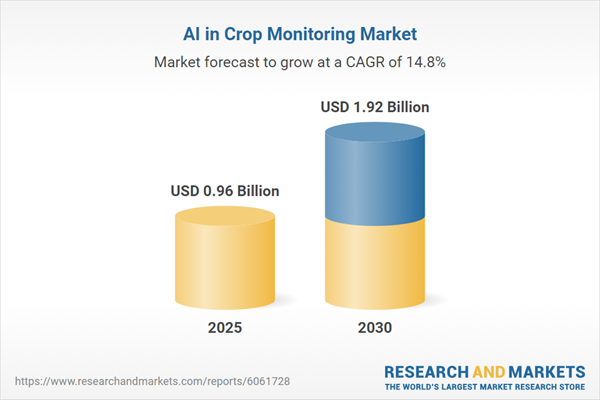The AI in crop monitoring market is set to witness robust growth at a CAGR of 14.80% during the forecast period to be worth US$1.921 billion in 2030 from US$0.963 billion in 2025.
The use of AI in crop monitoring within agriculture is on the rise, driven by advancements in AI and machine learning algorithms. This is enhancing the precision of crop monitoring capabilities. Sensor technology and the Internet of Things (IoT) are gaining traction for understanding and analyzing crop health and farm growth. Additionally, precision farming, which utilizes data and technology to tailor cultivation to specific landforms, has become more effective with AI's application in providing the necessary analysis and insights for data processing.
The use of AI in crop monitoring within agriculture is on the rise, driven by advancements in AI and machine learning algorithms. This is enhancing the precision of crop monitoring capabilities. Sensor technology and the Internet of Things (IoT) are gaining traction for understanding and analyzing crop health and farm growth. Additionally, precision farming, which utilizes data and technology to tailor cultivation to specific landforms, has become more effective with AI's application in providing the necessary analysis and insights for data processing.
AI in Crop Monitoring Market Drivers:
- Increasing Global Food Demand: The growing global demand for food is a primary driver for AI-powered crop monitoring solutions, as they help improve crop yields and resource utilization. According to research from the NIH, China's per capita wheat consumption is projected to increase to 76 kg in 2030 and 95 kg in 2050. Meanwhile, for India, estimates range from 60.4 to 74 kg by 2030, compared to 2019 levels.
- Government Intervention and Funding: Government initiatives and funding play a significant role in driving the AI in crop monitoring market by supporting research and development. Subsidies and grants from these government initiatives enable researchers to develop new AI algorithms, sensor technologies, and analysis tools for crop monitoring, while also making it easier for farmers to invest in AI-powered solutions.
AI in Crop Monitoring Market Geographical Outlook:
- Asia-Pacific: The Asia-Pacific region is experiencing growth due to increasing labor costs, land scarcity, and a growing population. China, India, and Japan are leading the adoption of AI solutions in this region.
- North America: North America is seeing increased investment in precision agriculture, particularly in the US and Canada, benefiting from a robust infrastructure and research base.
- Europe: Europe is focused on environmental trends, driving investment in these technologies. Germany, France, and the UK are investing in sustainable and precision farming concepts, supported by government initiatives promoting the adoption of agricultural technology.
- Middle East and Africa: The Middle East and Africa represent new frontiers for AI solutions in agriculture, especially in arid areas such as Saudi Arabia, the UAE, and South Africa, which are key countries for agri-tech in crop monitoring.
- South America: South America is witnessing growth, driven by the adoption of AI solutions in countries like Brazil and Argentina to address climate change and resource depletion.
Reasons for buying this report::
- Insightful Analysis: Gain detailed market insights covering major as well as emerging geographical regions, focusing on customer segments, government policies and socio-economic factors, consumer preferences, industry verticals, other sub- segments.
- Competitive Landscape: Understand the strategic maneuvers employed by key players globally to understand possible market penetration with the correct strategy.
- Market Drivers & Future Trends: Explore the dynamic factors and pivotal market trends and how they will shape up future market developments.
- Actionable Recommendations: Utilize the insights to exercise strategic decision to uncover new business streams and revenues in a dynamic environment.
- Caters to a Wide Audience: Beneficial and cost-effective for startups, research institutions, consultants, SMEs, and large enterprises.
What can businesses use this report for?
Industry and Market Insights, Opportunity Assessment, Product Demand Forecasting, Market Entry Strategy, Geographical Expansion, Capital Investment Decisions, Regulatory Framework & Implications, New Product Development, Competitive Intelligence.Report Coverage:
- Historical data & forecasts from 2022 to 2030
- Growth Opportunities, Challenges, Supply Chain Outlook, Regulatory Framework, Customer Behaviour, and Trend Analysis
- Competitive Positioning, Strategies, and Market Share Analysis
- Revenue Growth and Forecast Assessment of segments and regions including countries
- Company Profiling (Strategies, Products, Financial Information, and Key Developments among others)
AI in Crop Monitoring Market is analyzed into the following segments:
By Technology
- Machine Learning
- Computer Vision
- Predictive Analytics
- Others
By Offering
- Hardware
- Software
- Services
By Application
- Disease and Pest Management
- Precision Irrigation
- Yield Prediction
- Soil Health Monitoring
- Weed Control
By Geography
- North America
- USA
- Canada
- Mexico
- South America
- Brazil
- Argentina
- Others
- Europe
- United Kingdom
- Germany
- France
- Spain
- Others
- Middle East and Africa
- Saudi Arabia
- UAE
- Others
- Asia Pacific
- China
- Japan
- India
- South Korea
- Taiwan
- Australia
- Others
Table of Contents
1. INTRODUCTION
2. RESEARCH METHODOLOGY
3. EXECUTIVE SUMMARY
4. MARKET DYNAMICS
5. AI IN CROP MONITORING MARKET BY TECHNOLOGY
6. AI IN CROP MONITORING MARKET BY OFFERING
7. AI IN CROP MONITORING MARKET BY APPLICATION
8. AI IN CROP MONITORING MARKET BY GEOGRAPHY
9. COMPETITIVE ENVIRONMENT AND ANALYSIS
10. COMPANY PROFILES
Companies Mentioned
- Taranis
- Plantix
- Sentera
- Farmonaut Technologies Pvt. Ltd.
- EOS Data Analytics, Inc.
- CropX Inc.
Methodology

LOADING...
Table Information
| Report Attribute | Details |
|---|---|
| No. of Pages | 140 |
| Published | February 2025 |
| Forecast Period | 2025 - 2030 |
| Estimated Market Value ( USD | $ 0.96 Billion |
| Forecasted Market Value ( USD | $ 1.92 Billion |
| Compound Annual Growth Rate | 14.8% |
| Regions Covered | Global |
| No. of Companies Mentioned | 6 |









